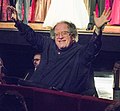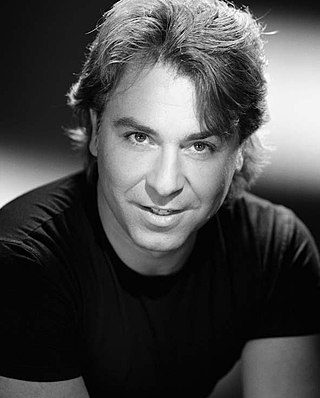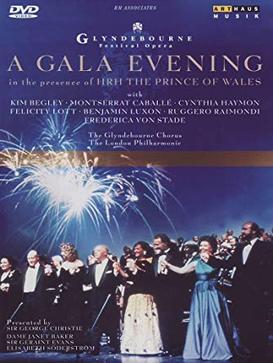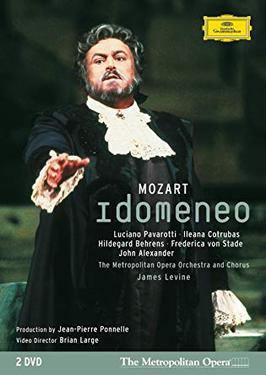Reviews
Donal Henahan reviewed the gala in The New York Times on 24 October 1983. Financial considerations, he wrote, had led the Metropolitan Opera to stage a concert which, including intermissions, ran for some eleven hours. The result was that "there were many stretches of unremarkable singing by minor or obscure artists". Indeed, "there were so many obscure names or unfamiliar faces that the listener had to keep diving into the program to learn their identities, and even then was seldom the wiser". Every opera company needed singers who, although well schooled and competent, were more or less anonymous, but it was questionable whether such artists should figure prominently in what was a once-in-a-lifetime jamboree. The Met's brisk stage management had not helped matters by hustling singers through their contributions without allowing the customary encores or floral tributes, or even more than a few ovations. It was disappointing to spend a long time at an event such as this without finding oneself shedding a nostalgic tear. [3]
This was not to say that the Met had not done "a magnificent job of hugging itself". Dotted amongst the gala were many moments that were "thrilling" and even "euphoric". [3]
Éva Marton was "galvanizing" in Turandot's "In questa reggia". Ruggero Raimondi was "wickedly funny" in Basilio's "La calunnia". Joan Sutherland's "glittering" "Bel raggio lusinghier" was the most ecstatic item of the entire event, and the most enthusiastically applauded. [3]
The Met's chorus played only a small part in the proceedings, but acquitted themselves well in the Prelude and "Hymn to the sun" from Mascagni's Iris. Catherine Malfitano and Alfredo Kraus were "touching" in a duet from Gounod's Roméo et Juliette. Nicolai Gedda was "excitingly ardent" in "Una furtive lagrima". [3]
In the trio from the concluding pages of Der Rosenkavalier, Kathleen Battle and Frederica von Stade sang "delectably", and Elisabeth Söderström was able to present a three-dimensional portrait of the Feldmarschallin despite having only a few minutes in which to do so. Mirella Freni and Plácido Domingo were "affecting" in a love duet from Otello. Preceded by a "somewhat ludicrous caricature of opera ballet" in which the Met's dancers enacted the Bacchanale from Samson et Dalila, Renato Bruson and Grace Bumbry performed a duet from Nabucco that was particularly enjoyable. Bruson was the epitome of cool serenity, but Bumbry sang electrifyingly in a voice that sounded "richer and more rested" than it had for a considerable while. [3]
It was after the final intermission, with midnight approaching, that the gala truly melted hearts. The curtain rose to reveal twenty-five of the Met's most distinguished former luminaries seated at the back of the stage like jurors in a vocal competition. Among them were Helen Jepson, Dorothy Kirsten, Zinka Milanov, Jarmila Novotná, Bidu Sayão, Eleanor Steber, Risë Stevens, Ferruccio Tagliavini, Cesare Valletti and Ramón Vinay. Their presence endowed the concert with a feeling of historical significance that it had thitherto lacked. It was worth the price of one's ticket just to watch the expressions on their faces as they listened to their successors singing in front of them. [3]
Leona Mitchell and Giuliano Ciannella sang the nuptial duet from Madama Butterfly, and the last of three laudable selections from Rossini came in the form of a "delectable exhibition of ... ensemble precision" in the finale to act 1 of L'italiana in Algeri. Marilyn Horne then lifted the occasion onto a new level of feeling and drama in a "sumptuous" rendition of "Mon cœur s'ouvre à ta voix", after which, to the manifest delight of the audience, she offered a wordless but eloquent embrace to Risë Stevens, the pre-eminent Dalila of her era. [3]
Birgit Nilsson, in a voice that betrayed her sixty-five years yet was still something to marvel at, performed Isolde's Narrative and Curse. One of her admirers was so overcome that an usher had to restrain him from invading the stage with a bouquet. In the evening's only encore, Nilsson then offered a Swedish folk song which, she explained, had been a favourite of her compatriot namesake, Christine Nilsson, who had been Faust's Marguerite on the opening night of the old Met in 1883. [3]
Leontyne Price and Luciano Pavarotti delivered a culminating, "soaring" love duet from Un ballo in maschera, the tenor "in clarion voice", the soprano more slender of form than of late but "never in recent years ... more voluptuous or freer" in her singing. But neither of them was likely to linger in the memory as vividly as Horne putting her arms around Stevens, or Nilsson's simple melody from her homeland. It was episodes such as these that were "the real stuff that opera galas are made of". [3]
Joseph McLellan reviewed the gala on Laserdisc in The Washington Post on 31 May 1985. It was, he wrote, "the most spectacular event in the history of opera". From the very first note of the Bartered bride overture in the middle of the afternoon to Luciano Pavarotti and Leontyne Price duetting in Verdian ecstasy in the small hours of the morning, "it was operatic caviar". No previous concert had brought together such a dazzling constellation of opera stars for a single event. The quality of the performances was uneven, but the best of them were "stratospheric". Nothing like this gala had ever been presented before [4]
Pioneer's pair of Laserdiscs omitted the gala's weaker items and abbreviated singers' comings and goings. The audio quality that they offered far outclassed that of PBS's broadcast. Collectors who enjoyed concerts of operatic excerpts sung by first class artists were sure to find Pioneer's release the most important issue of the year, and maybe even of the decade. [4]
The gala was also reviewed in Gramophone , [5] Opera Quarterly, [6] Richard M. Jacobs's and Ed Schwartz's Music Videodiscs: An Annual Guide, [7] Rebecca Krafft's and Brian O'Doherty's The Arts on Television, 1976–1990 [8] and Douglas Pratt's The Laser Video Disc Companion [9] and Doug Pratt's DVD Video Guide. [10]






































